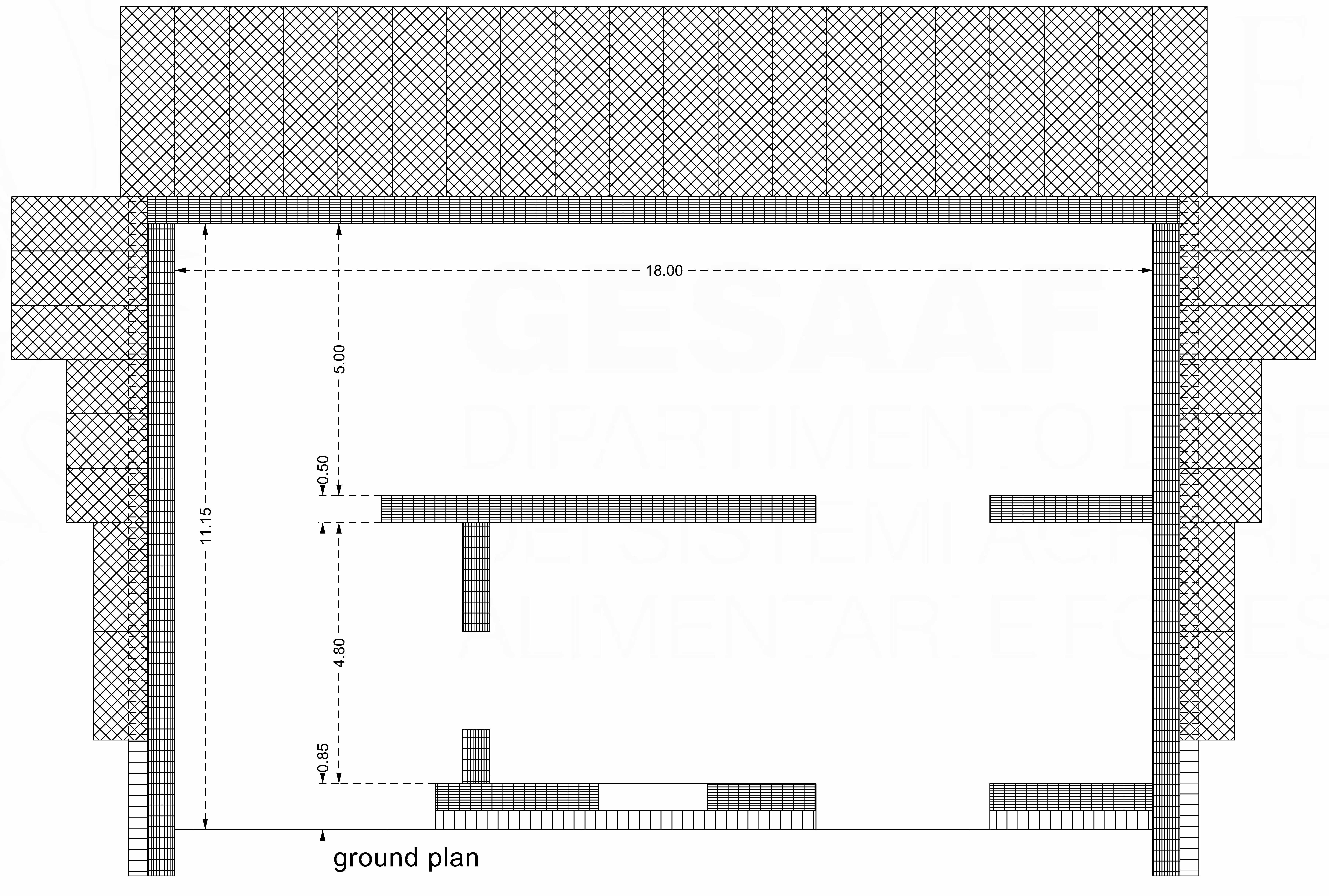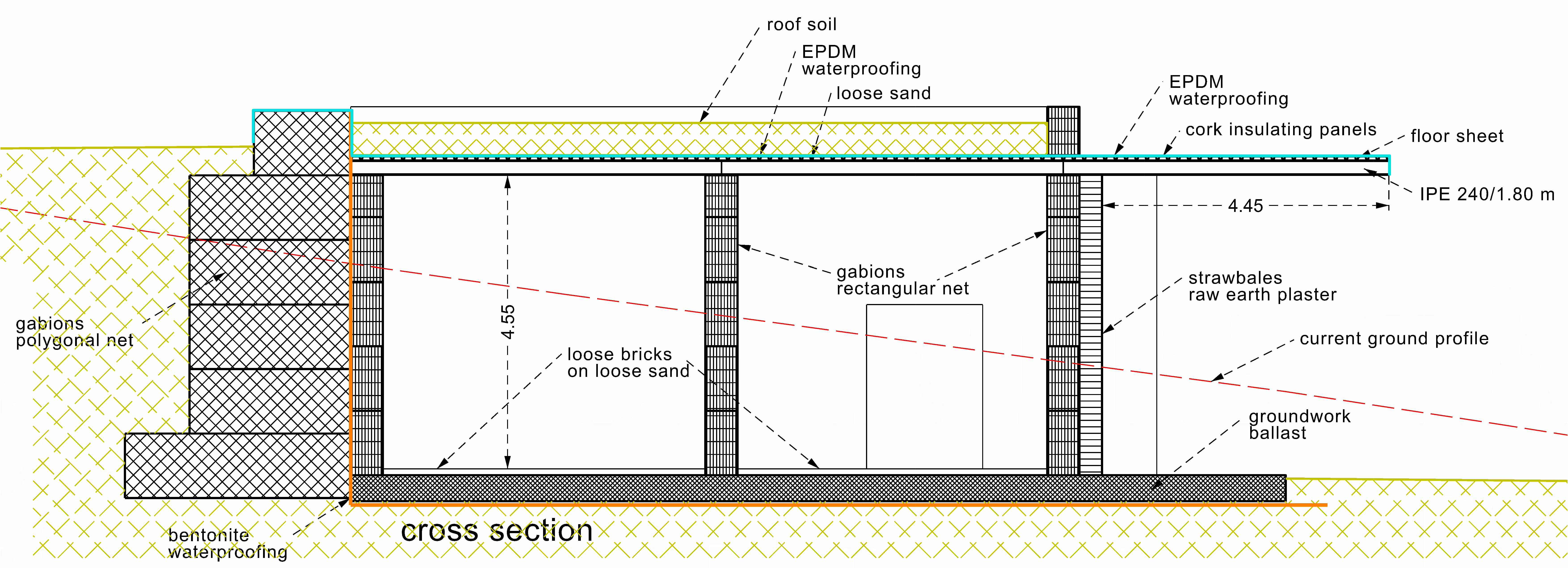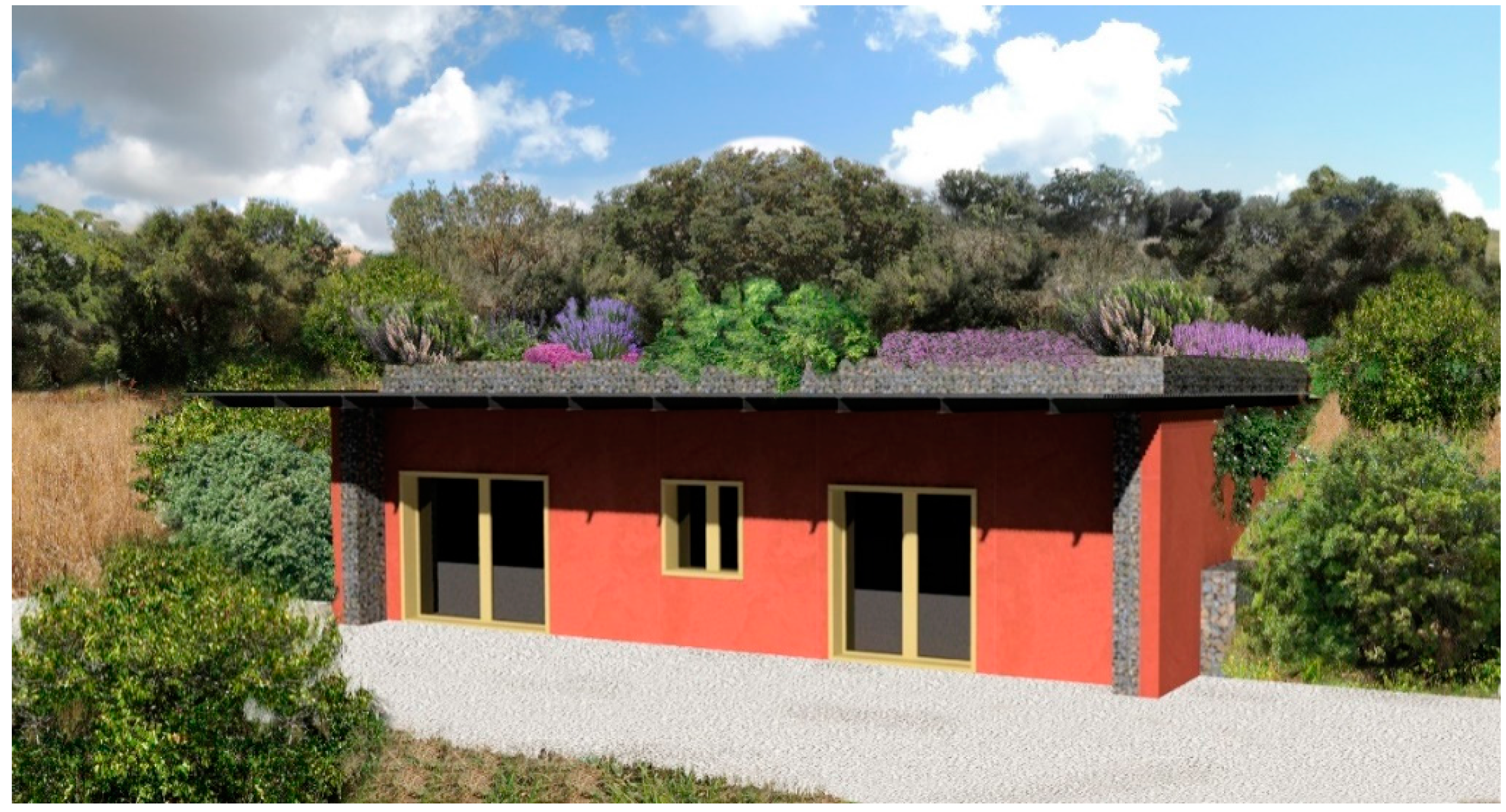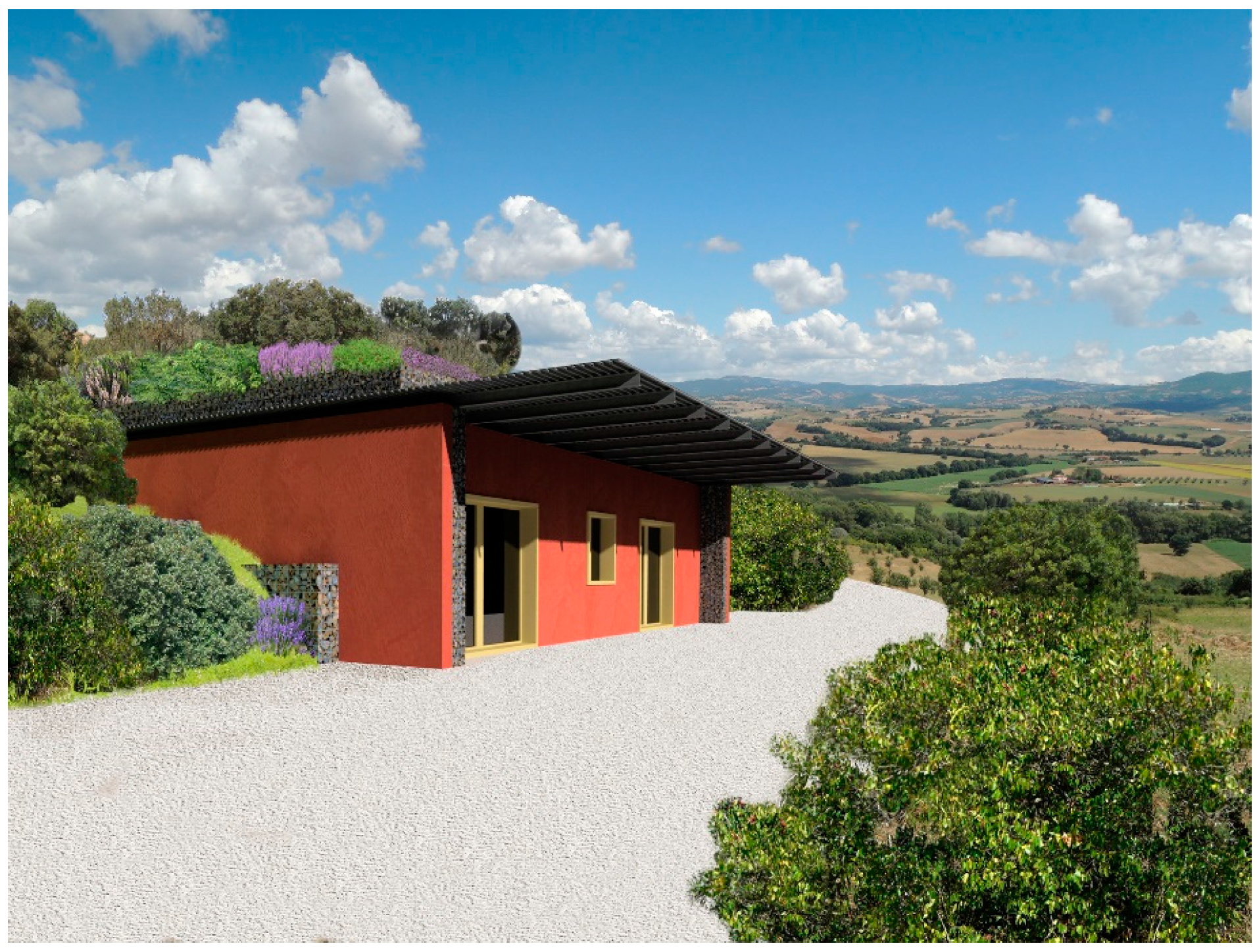Design of Sustainable Agricultural Buildings. A Case Study of a Wine Cellar in Tuscany, Italy
Abstract
:1. Introduction
2. Results
3. Discussion
4. Materials and Methods
4.1. Study Area
4.2. Preliminary Surveys
4.3. Building Materials
- Natural stone is one of the oldest building materials and is the natural material par excellence. Natural stone, in the present area available at km0, requires energy efforts concerning its life cycle greater than that of other materials, such as wood and raw earth [16]. However, the stone has no problems for disposal and any store of material gives rise to non-polluting deposits. From a thermodynamic point of view, the high thermal inertia of the stone, which has to, as a consequence, dephase in time and mitigate the peaks of the oscillations of the temperatures, makes it particularly suitable for use in a wine cellar, in which the maintenance of steady temperature is very important.
- The steel of the gabion baskets and of the load-bearing roof structure is an energetically expensive material both during the production and during the recycling processes. However, it has the feature of being totally recyclable for an unlimited number of times. In the world, over 400 million tons of metal is recycled each year, over 40% of the steel used comes from recycling, and the energy conservation compared to production from raw material is 65%–80% [17]. In the US, the recycling rate of structural steel (recycled steel/scrap steel generated in the same year) is close to 100% [18]. Even zinc used for steel galvanization is totally recyclable.
- In the present design, the straw constitutes the external cladding of the bearing wall completely off the ground, in substitution of materials in synthetic foam. Straw waste is an inevitable and generally undesirable consequence of the cultivation of cereals. The world cereals production in 2015 is expected to amount to 2.5 Gt, on 700 million hectares [19]. A small amount of straw is used as bedding in livestock, as biomass for energy production, and in other minor ways. However, in most cases, the straw represents a disposal problem and it is left to decompose or be burned on the field. As such, it requires further actions and, therefore, environmental and economic costs [20]. The straw, as well as wood, is a carbon sink, which is an accumulator of carbon dioxide. The CO2 is trapped in the straw for an indefinite amount of time and it goes back into the atmosphere through combustion or decomposition. When the straw waste is burned or when it decomposes, 1.00 ton of straw produces about 1.35 tons of CO2 [21]. Therefore, in order to promote the permanent storage of CO2, one of the best actions for global development is the use of straw waste as a building material in construction. The proposed design provides for straw packaged in rectangular bales [22], and it also comes from field harvesting.
- Raw earth and lime used for the plastering of walls are materials which have a high degree of sustainability. Lime and red ochre earth are used for coloring plasters.
- The bentonite clay sheets, used as the waterproofing system of the building, are disposed with a rate of very low or no pollution.
- The bricks used for flooring are made up of clay. They are removable, transportable and recyclable materials, without significant interventions in terms of energy costs.
- Cork insulating panels and ethylene-propylene diene monomer (EPDM) sheets are used in the roof, respectively, for insulating and waterproofing. The EPDM layers are simply placed on the structure and therefore they can be removed and possibly reused.
Acknowledgments
Author Contributions
Conflicts of Interest
References
- Horvath, A. Construction materials and the environment. Annu. Rev. Energ. Environ. 2004, 29, 181–204. [Google Scholar] [CrossRef]
- Dixit, M.K.; Fernández-Solís, J.L.; Lavy, S.; Culp, C.H. Identification of parameters for embodied energy measurement: A literature review. Energ. Build. 2010, 42, 1238–1247. [Google Scholar] [CrossRef]
- Arena, A.P.; De Rosa, C. Life cycle assessment of energy and environmental implications of the implementation of conservation technologies in school buildings in Mendoza-Argentina. Build. Environ. 2003, 38, 359–368. [Google Scholar] [CrossRef]
- Pacheco-Torgal, F. Eco-efficient construction and building materials research under the EU Framework Programme Horizon 2020. Constr. Build. Mater. 2014, 51, 151–162. [Google Scholar] [CrossRef]
- Dutil, Y.; Rousse, D.; Quesada, G. Sustainable buildings: An ever evolving target. Sustainability 2011, 3, 443–464. [Google Scholar] [CrossRef]
- Korjenic, A.; Klarić, S.; Hadžić, A.; Korjenic, S. Sheep wool as a construction material for energy efficiency improvement. Energies 2015, 8, 5765–5781. [Google Scholar] [CrossRef]
- Barbari, M.; Conti, L.; Monti, M.; Pellegrini, P.; Rossi, G.; Simonini, S.; Sorbetti Guerri, F. Antropizzazioni decostruibili per il non-consumo del territorio rurale: Progettazione per la decostruibilità. In Proceedings of the National Congress of the Italian Society of Agricultural Engineering, L’edilizia rurale tra sviluppo tecnologico e tutela del territorio, Firenze, Italy, 20–22 September 2012.
- Berge, B. The Ecology of Building Materials; Architectural Press Linacre House: Oxford, UK, 2001. [Google Scholar]
- Barbari, M.; Sorbetti Guerri, F.; Conti, L.; Monti, M.; Pini, L. Razionalizzazione ed ingegnerizzazione dell’utilizzo di materiali naturali locali per l’impiego in costruzioni ed infrastrutture in ambiente agricolo e periurbano toscano. In Proceedings of the IX National Congress of the Italian Society of Agricultural Engineering, Ricerca e innovazione nell’ingegneria dei biosistemi agro-territoriali, Ischia Porto, Italy, 12–16 September 2009.
- Barbari, M.; Conti, L.; Monti, M.; Pellegrini, P.; Rossi, G.; Simonini, S.; Sorbetti Guerri, F. Antropizzazioni decostruibili per il non-consumo del territorio rurale: Dallo sviluppo sostenibile alle antropizzazioni decostruibili. In Proceedings of the National Congress of the Italian Society of Agricultural Engineering, L’edilizia rurale tra sviluppo tecnologico e tutela del territorio, Firenze, Italy, 20–22 September 2012.
- Italian Regulations No. 2039. Regarding the Containment of the Land Consumption and Reuse of the Built Land; XVII Legislatura, Disegni di Legge e relazioni: Rome, Italy, 2014. [Google Scholar]
- ISPRA. Il Consumo di Suolo in Italia; Report 218/2015; TMB stampa srl: Roma, Italy, 2015. [Google Scholar]
- Turrini, D. Architetture di gabbioni. Costruire 2007, 293, 1–8. [Google Scholar]
- BS EN 10223-4 Steel Wire and Wire Products for Fencing and Netting. Steel Wire Welded Mesh Fencing; CEN: Bruxelles, Belgium, 2012.
- Rajapakse, R. Geotechnical Engineering Calculations and Rules of Thumb, 2nd ed.; Butterworth-Heinemann: Burlington, MA, USA, 2016; pp. 243–249. [Google Scholar]
- Ioannidou, D.; Zerbi, S.; Habert, G. When more is better e Comparative LCA of wall systems with stone. Build. Environ. 2014, 82, 628–639. [Google Scholar] [CrossRef]
- Worldsteel Association. Available online: http://www.worldsteel.org/steel-by-topic/sustainable-steel.html (accessed on 15 December 2015).
- British Metals Recycling Association. Available online: http://www.recyclemetals.org/about_metal_recycling (accessed on 15 December 2015).
- Crop Prospects and Food Situation, Report No.2 July 2015. Available online: http://www.fao.org/3/a-I4773E.pdf (accessed on 13 January 2016).
- Conti, L.; Dainelli, R.; Pellegrini, P.; Spugnoli, P.; Bonotti, L. Studio di filiere agricole sostenibili per la produzione di balle di paglia da costruzione—Risultati preliminari. In Proceedings of the National Congress of the Italian Society of Agricultural Engineering, L’edilizia rurale tra sviluppo tecnologico e tutela del territorio, Firenze, Italy, 20–22 September 2012.
- Sodagar, B.; Rai, D.; Jones, B.; Wihan, J.; Fieldson, R. The carbon reduction potential of strawbale housing. Build. Res. Inf. 2011, 39, 51–65. [Google Scholar] [CrossRef]
- King, B. Design of Straw Bale Buildings: The State of the Art; Green Building Press: San Raphael, CA, USA, 2007. [Google Scholar]







© 2016 by the authors; licensee MDPI, Basel, Switzerland. This article is an open access article distributed under the terms and conditions of the Creative Commons by Attribution (CC-BY) license (http://creativecommons.org/licenses/by/4.0/).
Share and Cite
Conti, L.; Barbari, M.; Monti, M. Design of Sustainable Agricultural Buildings. A Case Study of a Wine Cellar in Tuscany, Italy. Buildings 2016, 6, 17. https://doi.org/10.3390/buildings6020017
Conti L, Barbari M, Monti M. Design of Sustainable Agricultural Buildings. A Case Study of a Wine Cellar in Tuscany, Italy. Buildings. 2016; 6(2):17. https://doi.org/10.3390/buildings6020017
Chicago/Turabian StyleConti, Leonardo, Matteo Barbari, and Massimo Monti. 2016. "Design of Sustainable Agricultural Buildings. A Case Study of a Wine Cellar in Tuscany, Italy" Buildings 6, no. 2: 17. https://doi.org/10.3390/buildings6020017
APA StyleConti, L., Barbari, M., & Monti, M. (2016). Design of Sustainable Agricultural Buildings. A Case Study of a Wine Cellar in Tuscany, Italy. Buildings, 6(2), 17. https://doi.org/10.3390/buildings6020017







